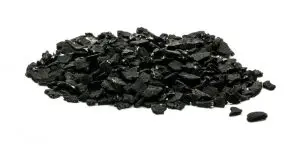What is Activated Carbon?
General Information about Activated Carbon and How it's Used
Activated carbon commonly referred to as activated charcoal is a highly porous material used to remove pollutants from contaminated liquid and gas streams. Activated carbon is derived from a variety of raw materials such as coconut, wood, coal (bituminous, anthracite, sub-bituminous, and lignite), peat, and bamboo. Each raw material has unique properties which effect the resulting pore structure, carbon content, and ash content, which are important characteristics when removing a contaminant of concern. The material is used in remediation, medical, and industrial applications where adsorption is required.
How does Activated Carbon Work?
Activated carbon has strong physical adsorption properties known as London Dispersion Forces which is a Van der Waals Force. The attraction between the activated carbon and the pollutant is highly dependent on the vapor pressure of the adsorbing molecules. Activated carbon is often altered or impregnated by chemicals to enhance the surface area of the carbon.
When the carbon is chemically altered the bonds are much stronger than London Dispersion Forces. Chemicals often impregnated on activated carbon include potassium hydroxide, phosphoric acid, or sulfur. With the addition of chemicals, the activated carbon will have an affinity for select compounds such acidic or basic pollutants. This type of reaction between the impregnated chemical and compound in the air is called a neutralization reaction. A neutralization reaction results in the products to form a salt and water on the activated carbon surface.
Why is Activated Carbon Eco-Friendly?
Activated carbon is a regenerable filtration media. Regeneration of activated carbon, also known as reactivating, is commonly completed by raising a kiln to high temperatures to destroy the adsorbed compounds in the pore structure of the activated carbon. Other methods may be used such as steam and solvents to remove pollutants from the carbon pore structure. The objective of regenerating the spent activated carbon is to restore the original pore structure and activity of the carbon so the carbon can be reused.
Upon completion of the regeneration process, the reactivated carbon may be used for other industrial air or water filtration uses. This allows the activated carbon to have a second life or second use before being disposed of. The alternative to reactivating the spent activated carbon is by landfill or incineration. These alternatives are costly and unsafe, especially if the material is deemed hazardous.
Recycled activated carbon is used widely in industry and is a sustainable approach over using virgin activated carbon. As a result of recycled or regenerated activated carbon facilities greenhouse gas emissions are overall lower than previously.
How is Activated Carbon Used?
Water Treatment
Activated carbon is used in water treatment projects for treating contaminated water. These types of contaminated water sources include groundwater, drinking water, surface water, or process water. Hydrosil works with industrial consultants and environmental remediation companies to treat a variety of compounds in water.
To learn more, visit Hydrosil’s Activated Carbon Used in Water Treatment page.
Air Treatment
Activated carbon is used in air treatment projects for treating odors and volatile organic compounds in air streams. Common systems that use activated carbon are HVAC systems (makeup air with trays or modules), tank or sump air vents, air stripper off-gas treatment, API separator vents, chemical processing facilities, and many more.
To learn more, visit Hydrosil’s Activated Carbon Used in Air Treatment page.
- Activated Carbon
- Organoclay
- Activated Alumina
